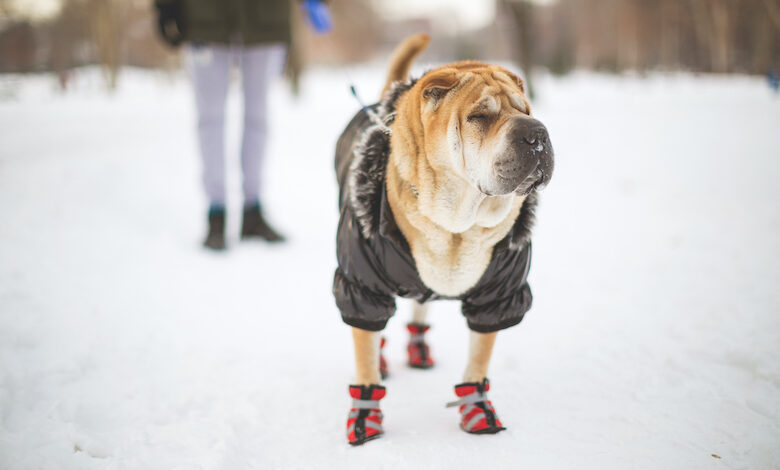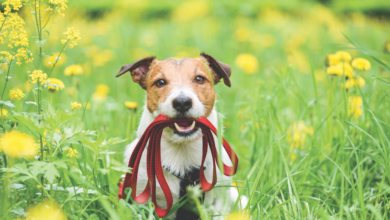Do Dogs Need Coats in the Winter? 7 Myths and Facts

Winter’s chill is making its presence known in many areas, and as we dig to the back of our closets and coat racks for parkas and seasonal outerwear, we wonder — do dogs need coats in the winter, too? Canine couture is popular, so whether your dog roams in a sweater, hoodie or goes au naturel when mother nature bites at the thermometer, we’ve got the facts — and the fictions — on dog coats and sweaters.
Do dogs need coats or sweaters to ward off winter chills? Photography by Liliya Kulianionak/Shutterstock.
1. Fiction: All dogs need to wear dog coats to protect them from the cold.
Fact: The first thing that people might wonder when thinking, “Do dogs need coats?” is — “Do ALL dogs need coats?” Not all dogs need a coat or sweater to keep them warm when venturing outside, but shorter-haired breeds, senior dogs, puppies and dogs with medical conditions do benefit from the additional warmth. Seek pet apparel that adequately covers the neck and belly, and also allows for neck-to-tail protection. One of my favorite winter finds is the Quinzee from Ruffwear, which I chose based on the above features and the cuteness factor, too.
2. Fiction: All dogs can become accustomed to wearing a coat.
Fact: Some dogs are uncomfortable wearing apparel and should never be forced to do so. While many dogs benefit from the additional layering in colder temperatures, try letting your dog wear the coat in the house for minutes at a time. If he or she is not responsive — or does the famous “freeze in place” pose — scratch the idea and move on.
3. Fiction: Larger dogs do not need to wear winter coats or sweaters.
Fact: When thinking, “Do dogs need coats?” some might automatically rule out bigger breeds. Some dogs were bred with a thicker or a more dense coat, including the Idiatrod-savvy Siberian Husky. But other bigger breeds might benefit from a coat, so assess each individual dog. Greyhounds are more sensitive to the colder weather, for example, so this particular breed could use the extra layering.
4. Fiction: If it looks like a sweater and acts like a sweater, it will keep my dog warm.
Fact: This is so not true. I like to get waterproof dog clothes for my Dexter, a Cocker Spaniel, so his thicker hair can stay dry on our winter snow-covered-sidewalk jaunts. In addition, waterproof apparel keeps him dry from dew-coated bushes and grass at the park. Much like my own winter coat does for me, a polar-fleece lining gives dogs comfort while protecting against colder temperatures.
5. Fiction: A dog’s coat should be snug to keep him or her as warm as possible.
Fact: Another question that goes along with, “Do dogs need coats” — “How should dogs wear coats?” Remember the kid from A Christmas Story, whose mom bundled him up and then he could not move? Consider your dog’s mobility. Just as you need to move in a coat, so does your dog. Snug but not tight is a good rule.
Make sure there are no additional hanging zippers, snaps or parts that can rub or irritate a dog. Dexter will wear apparel as long as it doesn’t interfere with his “man parts.” Pay attention to where any Velcro straps or fasteners lay against a dog’s coat. Being able to try clothing on at the store helps a great deal.
6. Fiction: A dog’s pads are resilient and will protect him or her from nature’s elements.
Fact: Chemicals can be absorbed through a dog’s sensitive pads. In turn, those chemicals (such as what’s found in antifreeze) can be licked by dogs and cause severe problems. I use Musher’s Secret on my dog’s feet and have given this product as a stocking stuffer to dog-loving friends and family in the past.
Some people opt for dog booties, which is a smart idea in the winter months. Wash dog pads off thoroughly after a walk, perhaps using some warm water and a washcloth to melt any ice balls that may have formed on the bottom of their feet.
7. Fiction: Coats and hoodies must look heavy to adequately protect dogs.
Fact: Technology has evolved in the human-outerwear market, and the same holds true with our canine counterparts. Thin is the new thick in outerwear. Check labels and do research before making an investment. Heavier does not mean better; in fact, if a coat is too warm, dogs can overheat, so use caution.
Check out these 11 types of dog coats right here >>
How to measure your dog for a coat
Something else you might wonder when thinking, “Do dogs need coats?” is — “How do you measure your dog for a coat?” If you order a personalized jacket or sweater, keep in mind that many stores will not allow coats to be returned. So, measure your dog adequately before making any parka purchases.
Here’s how: With the dog standing up, run a tape measure from the base of the dog’s neck (where the collar would sit) and to the base of the tail. The majority of dog clothes use this measurement. Knowing your dog’s chest measurement will ensure a good fit, too.
Featured Image: miodrag ignjatovic/Getty Images. This post was originally published in 2012.






